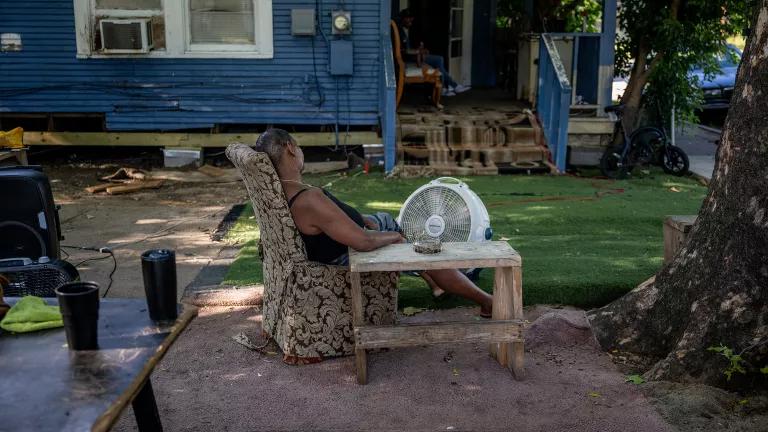Public Utility Commissions: Swiss Army Knives of Protection
With the United States in the midst of the COVID-19 crisis, there’s been a significant focus on a new federal rescue package. While this is crucial, the truth is that we need every level of government to tackle this crisis. NRDC and our partners are pushing for state decisionmakers to shield their residents from harm by preventing utility shutoffs.

iStock
This blog entry was co-authored with Ryan Treves, Schneider Summer Fellow with Energy Efficiency for All and NRDC.
The federal government has received a great deal of attention in the discussion of how to protect communities during the COVID-19 crisis. However, quiet groups of state regulators you may never have heard of have a great deal of power to help carry us through this pandemic: public utility commissions (PUCs). They decide whether and how many utilities can disconnect electricity and gas service due to non-payment by their financially strapped customers, many of whom are disproportionately facing the health and economic burdens of COVID-19. In a few states (Wisconsin, Maine, and Indiana), these commissions also regulate all water utilities; in most others they regulate investor-owned water utilities that serve a minority of the population.
Without doubt, America is stunningly, tragically failing in the fight against COVID-19. Others note how inexcusable this is because we saw it coming, like a gray rhino barreling down the road. And it will get worse, as even President Trump admitted recently.
Thankfully, there’s been a lot of focus on a new federal rescue package. While this is unquestionably crucial, as NRDC colleagues note here, here, and here, the simple truth is that we need every level of government to tackle this crisis.
So what’s the role of state decisionmakers? NRDC and our partners—including those we work with on the Energy Efficiency for All (EEFA) Project—are pushing for states to shield their most vulnerable residents from harm, especially those in low-income communities and black and brown communities, such as by preventing electric and gas utility shutoffs, as well as water shutoffs.
A tsunami is coming
Unfortunately, we now face the end of moratoriums on utility shutoffs in several states, leaving many people at risk of losing essential services: this can make following health recommendations, like hand-washing with hot water and staying home, next to impossible. Our friend and ally Katrina Metzler of the National Energy & Utility Affordability Coalition (NEUAC) aptly referred to this shutoff tsunami as a “crisis in the middle of a crisis.” And this compounds inequities disproportionately burdening under-resourced communities, which have historically faced large energy burdens. And the most painful burden—utility shutoffs—already have a track record of hitting low-income and Black households especially hard, as the NAACP found in a recent report.
Enhanced monthly unemployment benefits of $600 expired last week, despite widespread pain (for example, 388 out of 389 metro areas report higher unemployment compared to a year ago). This is driving people over a new utility shutoff cliff, as NEUAC notes in a fact sheet about COVID-19’s devastating impacts: “More than 1/4 of those who lost jobs during the COVID-19 crisis reported skipping or needing to skip a utility bill payment…[and a] 1 percent increase in the unemployment rate is associated with a 13 percent increase in the likelihood of experiencing bill hardship and a 16 percent increase in the probability of having one’s utilities disconnected.”
At the same time, utilities need income to continue providing service to all their customers. This puts PUCs on the hook since, as utility regulation expert Scott Hempling sums up, “We use regulation to align private behavior with the public interest, in situations where private behavior, unregulated, would conflict with the public interest.” (for a useful essay by him on this topic, click here).
Utility shutoff decision-makers
How do we confront this surge of utility shutoffs? Every state has a decision-making PUC which is largely responsible for that. There are about 200 regulators who serve on these commissions nationwide, and they are tasked with making policy that governs how electric, gas, water, and telecom utilities operate. Their jurisdiction is typically limited to investor-owned utilities, or “IOUs.” This is still a lot of turf, with 72 percent of Americans getting electricity from an IOU, with most others served by publicly-owned utilities governed by local boards.
The wide range of policy tools available to PUCs, driving a suite of outcomes from expanding high-speed internet to administering energy assistance, along with setting the utility service rates, makes them uniquely positioned to confront the current crisis. While most of us aren’t familiar with these commissions, their potential effectiveness and versatility makes them the policymaker equivalent of Swiss Army knives in facing down this pandemic.
Here are some big steps PUCs should take help the millions struggling to pay their energy bills:
- The first obvious step (and many have done so at one point or another since March) is to reinstate or extend shutoff moratoria.
- However, this doesn’t help customers disconnected before a moratorium. To protect them, commissions should order utilities to take measures to reconnect customers freely and efficiently. The Illinois Commerce Commission, for example, ordered no-cost reconnections until late December thanks to public input, including comments from EEFA (this order also included longer payment plans, waived deposits, and other strong protections).
- A third critical tool is assisting customers in paying their utility bills. As outlined in EEFA’s Pandemic Response Guidance, PUCs should suspend late fees and credit reporting, extend arrearage management plans, expand energy assistance funds during the emergency and the recovery period, allow for cross-eligibility with other programs, enable online enrollment, offer payment plans, and set up arrearage forgiveness.
- Through all of this, publicly available data is key to understanding the extent of the problem and how to best design and target responses to it: PUCs have the power to order utilities to file regular reports of customers disconnected and reconnected, customers on bill repayment plans, as well as costs & revenues for the utilities. The National Consumer Law Center’s Covid-19 reporting guide reinforces that “home energy affordability challenges and their often-dire consequences remain invisible” without this data.
- Finally, instead of making these orders bureaucratic and bewildering to customers, PUCs should order clear and inclusive customer outreach on behalf of utilities. For example, EEFA emphasizes that communications about new rules must be available in multiple languages.
To be clear, there are other leaders who have stepped up to tackle the gray rhino. For example, utilities have voluntarily taken steps to prevent customer shutoffs, as our colleague Kit Kennedy wrote here, with approval of their PUCs. Some governors and legislatures have stepped up as well.
And other agencies can also be allies: For example, most states have an official consumer advocate working to ensure the PUC is doing a good job. We urge you to find out what your consumer advocate is doing to hold your PUC accountable for delivering safe and affordable utility service—an essential need, especially during a pandemic—to vulnerable consumers. In fact, the National Association of State Utility Consumer Advocates (NASUCA) recently adopted a resolution providing useful guidance for states to protect consumers. In some states, state Attorney Generals can also play this role in PUC proceedings.
Governors and state legislatures can and should also use their authority to act. They play an essential role and have established statewide moratoria, reconnection requirements, and other consumer protections in some states, which apply both to utility commission-regulated utilities and to the publicly-owned utilities that are largely beyond the reach of those commissions. State legislatures can also appropriate funds, including drawing on federal COVID-19 relief funds, to help customers pay accumulated arrears to avoid shutoffs.
A time for leadership
Scott Hempling aptly titled a book of essays on this crucial topic “Preside or Lead?,” which describes the most important attributes and actions of utility commissioners who shine as real leaders. There is ample opportunity and desperate need for more of these important public officials to take bold, equitable action now as the pandemic shows no sign of abating.
Because in the end, these are public utility commissions. They were created to serve the people. They need to lead, so everyone to have essential, life-saving utility services connected during this crisis, especially the low-income communities and black and brown communities being hit hardest.



